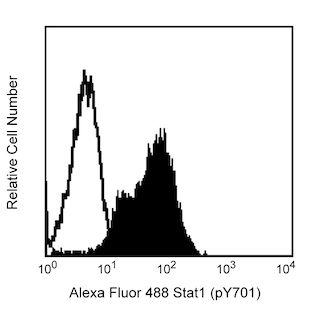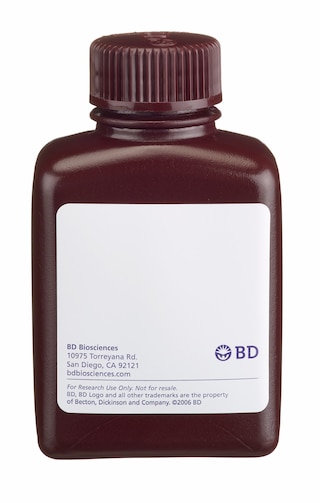Old Browser
This page has been recently translated and is available in French now.
Looks like you're visiting us from {countryName}.
Would you like to stay on the current country site or be switched to your country?


.png)

Analysis of Stat3 (pS727) in monocytes. Human peripheral blood mononuclear cells (PBMC) were either stimulated with 40 nM PMA (Sigma, P8139) for 15 minutes (shaded histogram) or unstimulated (open histogram). The cells were fixed (BD Cytofix™ buffer, Cat. No. 554655) for 10 minutes, then permeabilized (BD Phosflow™ Perm Buffer III, Cat. No. 558050) on ice for at least 30 minutes, and then stained with Alexa Fluor® 488 anti-Stat3 (pS727) (Cat. No. 558085). Monocytes were selected by scatter profile. Flow cytometry was performed on a BD™ FACSCalibur flow cytometry system.
.png)

BD™ Phosflow Alexa Fluor® 488 Mouse Anti-Stat3 (pS727)
.png)
Regulatory Status Legend
Any use of products other than the permitted use without the express written authorization of Becton, Dickinson and Company is strictly prohibited.
Preparation And Storage
Product Notices
- This reagent has been pre-diluted for use at the recommended Volume per Test. We typically use 1 × 10^6 cells in a 100-µl experimental sample (a test).
- For fluorochrome spectra and suitable instrument settings, please refer to our Multicolor Flow Cytometry web page at www.bdbiosciences.com/colors.
- The Alexa Fluor®, Pacific Blue™, and Cascade Blue® dye antibody conjugates in this product are sold under license from Molecular Probes, Inc. for research use only, excluding use in combination with microarrays, or as analyte specific reagents. The Alexa Fluor® dyes (except for Alexa Fluor® 430), Pacific Blue™ dye, and Cascade Blue® dye are covered by pending and issued patents.
- Alexa Fluor® 488 fluorochrome emission is collected at the same instrument settings as for fluorescein isothiocyanate (FITC).
- Caution: Sodium azide yields highly toxic hydrazoic acid under acidic conditions. Dilute azide compounds in running water before discarding to avoid accumulation of potentially explosive deposits in plumbing.
- Source of all serum proteins is from USDA inspected abattoirs located in the United States.
- Alexa Fluor® is a registered trademark of Molecular Probes, Inc., Eugene, OR.
- Please refer to www.bdbiosciences.com/us/s/resources for technical protocols.
- This product is provided under an intellectual property license between Life Technologies Corporation and BD Businesses. The purchase of this product conveys to the buyer the non-transferable right to use the purchased amount of the product and components of the product in research conducted by the buyer (whether the buyer is an academic or for-profit entity). The buyer cannot sell or otherwise transfer (a) this product (b) its components or (c) materials made using this product or its components to a third party or otherwise use this product or its components or materials made using this product or its components for Commercial Purposes. Commercial Purposes means any activity by a party for consideration and may include, but is not limited to: (1) use of the product or its components in manufacturing; (2) use of the product or its components to provide a service, information, or data; (3) use of the product or its components for therapeutic, diagnostic or prophylactic purposes; or (4) resale of the product or its components, whether or not such product or its components are resold for use in research. For information on purchasing a license to this product for any other use, contact Life Technologies Corporation, Cell Analysis Business Unit Business Development, 29851 Willow Creek Road, Eugene, OR 97402, USA, Tel: (541) 465-8300. Fax: (541) 335-0504.
- Please refer to http://regdocs.bd.com to access safety data sheets (SDS).
- Alexa Fluor™ is a trademark of Life Technologies Corporation.
- Human donor specific background has been observed in relation to the presence of anti-polyethylene glycol (PEG) antibodies, developed as a result of certain vaccines containing PEG, including some COVID-19 vaccines. We recommend use of BD Horizon Brilliant™ Stain Buffer in your experiments to help mitigate potential background. For more information visit https://www.bdbiosciences.com/en-us/support/product-notices.
Companion Products


The 49/p-Stat3 monoclonal antibody recognizes the S727-phosphorylated form of Signal transducer and activator of transcription 3 (Stat3/STAT3 isoform 1). The fluorochrome-conjugated formats have been evaluated using a human model system. However, the unconjugated form of this antibody is also effective for western blot analysis of human, mouse, and rat tissue. The Stat proteins function both as cytoplasmic signal transducers and as activators of transcription. Seven mammalian Stat proteins have been identified: Stat1-4, Stat5a, 5b, and Stat6. Stat3 is a 92-kDa protein that is activated as a DNA binding protein through cytokines, such as IL-6, and growth factors, such as EGF. Stat3 is phophorylated at serine 727 (S727) via the MAPK pathway. The S727 residue is located at a conserved Pro-X-Ser-Pro sequence, which is recognized by the protein kinase ERK. Activation through the S727 residue is thought to lead to initiation of transcription. Upon activation, Stat3 dimerizes, translocates to the nucleus, and binds DNA response elements thereby regulating gene expression. It appears that Stat3 binds to DNA as a homodimer, but it is also capable of binding as a heterodimer with Stat1. In addition to serine phosphorylation, Stat3 is also phosphorylated at tyrosine 705 by JAK1 in response to cytokine stimulation. Stat3 is widely expressed and can bind to the sis-inducible element (SIE) site from the c-fos promoter. This site is similar to the GAS element that is present in IFN--induced genes. Thus, phosphorylation of S727 in Stat3 occurs in response to growth factors and cytokines, and is essential for normal transcriptional activity.
Development References (4)
-
Fu XY, Zhang JJ. Transcription factor p91 interacts with the epidermal growth factor receptor and mediates activation of the c-fos gene promoter. Cell. 1993; 74(6):1135-1145. (Biology). View Reference
-
Kanai M, Konda Y, Nakajima T, et al . Differentiation-inducing factor-1 (DIF-1) inhibits STAT3 activity involved in gastric cancer cell proliferation via MEK-ERK-dependent pathway. Oncogene. 2003; 22(22):548-554. (Biology). View Reference
-
Schuringa JJ, Dekker LV, Vellenga E, Kruijer W. Sequential activation of Rac-1, SEK-1/MKK-4, and protein kinase Cδ is required for interleukin-6-induced STAT3 Ser-727 phosphorylation and transactivation. J Biol Chem. 2001; 276:27709-27715. (Biology).
-
Smith PD, Crompton MR. Expression of v-src in mammary epithelial cells induces transcription via STAT3. Biochem J. 1998; 15:331-381. (Biology). View Reference
Please refer to Support Documents for Quality Certificates
Global - Refer to manufacturer's instructions for use and related User Manuals and Technical data sheets before using this products as described
Comparisons, where applicable, are made against older BD Technology, manual methods or are general performance claims. Comparisons are not made against non-BD technologies, unless otherwise noted.
For Research Use Only. Not for use in diagnostic or therapeutic procedures.
Report a Site Issue
This form is intended to help us improve our website experience. For other support, please visit our Contact Us page.